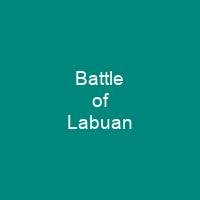The Battle of Labuan: A Turning Point in World War II
Imagine a small island, Labuan, nestled in the heart of North Borneo. This unassuming piece of land would soon become the stage for one of the most significant battles of World War II. The Battle of Labuan, fought between Allied and Imperial Japanese forces in June 1945, was a pivotal moment that marked the beginning of Japan’s downfall in Southeast Asia.
The Strategic Importance of Labuan
Labuan’s strategic location made it an essential target. The island had limited port facilities but boasted a crucial airfield, No. 1 Strip, which could host Royal Australian Air Force units. The main purpose of the Allied attack on Brunei Bay was to secure this base and gain control over oil fields and rubber plantations in the region.
The Japanese Occupation
Before the battle, Labuan had been under British administration with a population of 8,960. However, when Japanese forces captured the island in January 1942, they imposed harsh policies on its inhabitants. The occupation was marked by suppression and brutality, including the imprisonment of 131 rebels in 1943.
The Allied Plan
As the Allies advanced towards Borneo, their plans evolved. The initial landing on Tarakan island followed by invasions of Balikpapan and Banjarmasin were part of a broader strategy to establish strategic positions controlling the seas off Japan’s occupied coast between Singapore and Shanghai.
The 9th Division’s Arrival
The 9th Division, led by Major General George Wootten, began moving from Australia to Morotai in March 1945. By May, final preparations were underway for the landings on Labuan. The operation was rescheduled due to shipping shortages, but when it finally took place on June 10, the landing went smoothly.
The Battle Itself
Brigadier Selwyn Porter led the 24th Brigade Group, tasked with capturing Labuan and securing Brunei and Muara Island. Two infantry battalions landed simultaneously near Victoria, with artillery and heavy mortars arriving in subsequent waves. The battle was intense but ultimately successful, with minimal opposition from Japanese forces.
The Final Push
Despite initial success, the 24th Brigade faced resistance at a Japanese stronghold position. Intense bombardment over several days weakened the enemy, allowing for a final assault on June 21. The battle resulted in significant casualties but secured Labuan for Allied forces.
The Aftermath
Once secure, Labuan was transformed into a major base. The airfield at No. 1 Strip was repaired and expanded to host RAAF units. Engineers undertook extensive construction projects, including new port facilities, bridges, oil tanks, and roads. By the end of June, the island had become a vital asset for Allied operations in the region.
The Legacy of Labuan
Labuan’s role as a strategic base continued even after the war ended. The Australian military conducted trials to prosecute suspected Japanese war criminals on the island. Today, visitors can explore memorials and cemeteries that honor those who fought and died during this tumultuous period.

The Battle of Labuan stands as a testament to the resilience and determination of Allied forces. It marked a turning point in the war, paving the way for Japan’s eventual surrender. As we reflect on this historic battle, let us remember the sacrifices made by those who fought and the enduring legacy of Labuan.
You want to know more about Battle of Labuan?
This page is based on the article Battle of Labuan published in Wikipedia (retrieved on November 28, 2024) and was automatically summarized using artificial intelligence.







